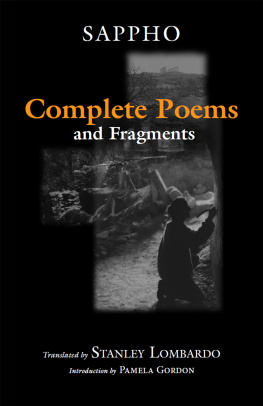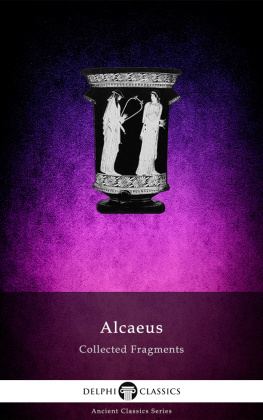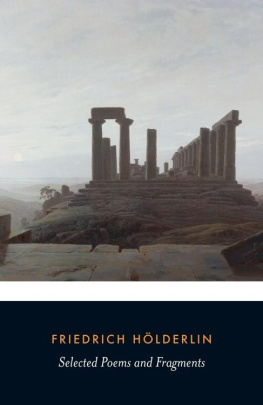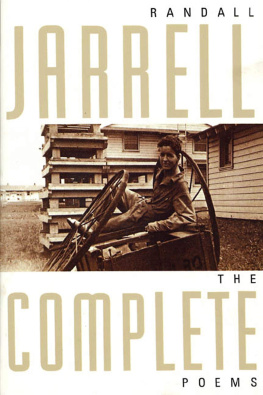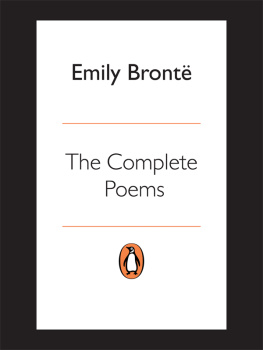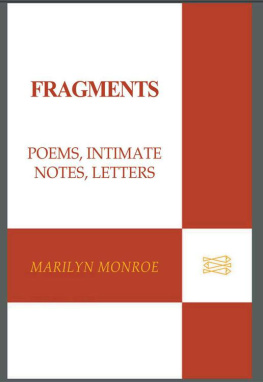Gordon Pamela - Complete Poems and Fragments
Here you can read online Gordon Pamela - Complete Poems and Fragments full text of the book (entire story) in english for free. Download pdf and epub, get meaning, cover and reviews about this ebook. City: Cambridge;Indianapolis;Indiana, year: 2016, publisher: Hackett Publishing Company, Incorporated, genre: Romance novel. Description of the work, (preface) as well as reviews are available. Best literature library LitArk.com created for fans of good reading and offers a wide selection of genres:
Romance novel
Science fiction
Adventure
Detective
Science
History
Home and family
Prose
Art
Politics
Computer
Non-fiction
Religion
Business
Children
Humor
Choose a favorite category and find really read worthwhile books. Enjoy immersion in the world of imagination, feel the emotions of the characters or learn something new for yourself, make an fascinating discovery.
- Book:Complete Poems and Fragments
- Author:
- Publisher:Hackett Publishing Company, Incorporated
- Genre:
- Year:2016
- City:Cambridge;Indianapolis;Indiana
- Rating:4 / 5
- Favourites:Add to favourites
- Your mark:
- 80
- 1
- 2
- 3
- 4
- 5
Complete Poems and Fragments: summary, description and annotation
We offer to read an annotation, description, summary or preface (depends on what the author of the book "Complete Poems and Fragments" wrote himself). If you haven't found the necessary information about the book — write in the comments, we will try to find it.
Complete Poems and Fragments — read online for free the complete book (whole text) full work
Below is the text of the book, divided by pages. System saving the place of the last page read, allows you to conveniently read the book "Complete Poems and Fragments" online for free, without having to search again every time where you left off. Put a bookmark, and you can go to the page where you finished reading at any time.
Font size:
Interval:
Bookmark:

Stanley Lombardo
Pamela Gordon
Indianapolis/Cambridge
Copyright 2016 by Hackett Publishing Company, Inc.
All rights reserved
Printed in the United States of America
19 18 17 16 1 2 3 4 5 6 7
For further information, please address
Hackett Publishing Company, Inc.
P.O. Box 44937
Indianapolis, Indiana 46244-0937
www.hackettpublishing.com
Cover design by Brian Rak
Composition by William Hartman
Library of Congress Cataloging-in-Publication Data
Names: Sappho, author. | Lombardo, Stanley, 1943 translator.
Title: Complete poems and fragments / Sappho ;
translated by Stanley Lombardo ; introduction by Pamela Gordon.
Description: Indianapolis ; Cambridge : Hackett Publishing
Company, 2016.
Identifiers: LCCN 2015041308 | ISBN 9781624664687 (cloth)
| ISBN 9781624664670 (pbk.)
Subjects: LCSH: SapphoCriticism and interpretation.
Classification: LCC PA4408.E5 L653 2016 | DDC 884/.01dc23
LC record available at http://lccn.loc.gov/2015041308
ePub ISBN: 978-1-62466-710-7
Homer, Iliad. Translated by Stanley Lombardo. Introduction by Sheila Murnaghan.
Homer, Odyssey. Translated by Stanley Lombardo. Introduction by Sheila Murnaghan.
Sappho, Poems and Fragments. Translated by Stanley Lombardo. Introduction by Pamela Gordon.
For
Li & Mei
Lily & Madison
&
Bailey Mae
SEARCHING FOR SAPPHO
Sappho was a Greek poet who lived on the island of Lesbos in the late seventh and early sixth centuries B.C.E. But she is also a construct, a phantom, an icon. Writing about her is a hazardous enterprise. The surviving texts are few (two or three complete poems, plus the scattered remnants), and the legends are vast. With so few verses and so many myths to go on, a writer inevitably exposes more about her own context than she can reveal about Sapphos.
Even the textual tradition of Sapphos poems has mythic qualities. To start from what might have been the end, legend has it that the early church ordered Sapphos books to be burnt, and thus reduced us to eking out our text of Sappho from scraps and leavings. Whether or not deliberate book-burnings hastened the damage wrought by time and bad luck, the survival of the slender corpus as it exists today is as good a story. Roughly two-thirds of the verses that survive today were lost for over a millennium, to resurface only in the last years of the nineteenth and the first decades of the twentieth and twenty-first centuries. Some survived in improbable ways. Sapphos second fragment provides a striking example. Broken clay pots were often recycled into scrap paper in antiquity, and among the usual receipts and shopping lists, one occasionally finds an oddly enchanting message such as: Leave the saw under the sill of the garden gate (scratched on a potsherd found in Athens). But one particular broken pot delivers a message of a different order:
... down from the mountain-top...
and out of Crete, come to me here
in your sacred precinct, to your grove
of apple trees and your altars
smoking with incense,
{x} where cold water flows babbling
through the branches, the whole place
shadowed with roses...
This text, along with the rest of fragment 2, was lost until 1937, when the Italian scholar Medea Norsa published it, along with a photograph of the potsherd on which it was written. The text clearly represents the lyrics of a song to Aphrodite, the Greek goddess of erotic love (also called Cypris, as at the end of this fragment). We know the fragment belongs to Sappho because almost every word matches what we know of Sapphos Aeolic Greek dialect, and because the text overlaps with three previously known snippets identified explicitly as Sapphos: one quoted in Athenaeus The Learned Banquet, and two others in Hermogenes On Kinds of Style (both Greek writers from the second-century C.E.). Like those quotations, the potsherd text was selected and copied at some remove from the poets own world. The writing on the pottery scrap itself has since deteriorated, but the 1937 photograph reveals a graceful hand, in pen and ink. In many Greek-speaking areas, the usual way to write on a piece of pottery was to scratch the letters with a sharp tool, but pen and ink were the norm in Egypt. Thus, the potsherd comes to us not from Lesbos (or Mytilene, as Sapphos island is now called), but presumably from Egypt. The style of handwriting dates the text to somewhere around the third-century B.C.E., perhaps three or four hundred years after Sappho.
We cannot know how the lyrics of fragment 2 came to be written on a broken pot. Some scholars imagine a wistful lover wanting to have these words close at hand, as though they might charm an idyllic love scene into reality. Others posit more prosaic contexts: a scribe practicing the trade, or a student obediently responding to dictation. For the other fragments, the circumstances of survival are more transparent. Most of Sapphos extant poems come to us in one of two ways: either as centuries-old scraps of papyrus or parchment (ancient equivalents to paper), or as quotations in various books that were copied and passed along from era to era.
When ancient pieces of papyrus are fortuitously preserved, we usually end up with random snatches of discontinuous text, as in the beginning of fragment 21 in this edition:
ally end up with random lament
ally end up with random1 trembling
{xi} The circumstances of the survival of such shreds of textand three twenty-first-century discoverieswill be discussed below. Quotations, on the other hand, are examples cited by ancient scholars who could not know that their essays and handbooks would outlive the bulk of Sapphos entire corpus. Several of the briefest quotations end with the words and so on, as though any reader could be expected to know the full text. This type of fragment usually preserves at least a full phrase, as in fragment 52:
I do not expect to graze the sky.
This verse has endured simply because a second-century C.E. scholar was interested in Sapphos unusual spelling of the Greek word for sky. To cite another example: the rhetorician Hermogenes quotes where cold water flows babbling / through the branches (also in the potsherd fragment quoted above) as an example of a simple description that brings pleasure to the ear, just as beholding the beauty of the actual place would bring pleasure to the eye.
Until the end of the nineteenth century, such embedded quotations were the only known texts of Sappho. Fortunately, a few of them are just long enough to give us a glimpse of Sapphos genius. Poem 1 in this edition is cited in full by Dionysius of Halicarnassus, a Greek critic and historian who taught rhetoric in Rome in the first-century B.C.E. Praising the way the words are interwoven, Dionysius quotes poem 1 in his essay On Literary Composition as an example of polished and exuberant expression.
The other quotation of significant length is the almost complete Sappho 31, which comes to us from On the Sublime, a work on literary genius attributed to a shadowy first-century C.E. figure usually referred to as Longinus. Longinus quotes fragment 31 as an example of brilliance in isolating and juxtaposing the symptoms of intense erotic desire. Longinus rightly admires how the poem describes the lovers heightened awareness of the convergence (
Font size:
Interval:
Bookmark:
Similar books «Complete Poems and Fragments»
Look at similar books to Complete Poems and Fragments. We have selected literature similar in name and meaning in the hope of providing readers with more options to find new, interesting, not yet read works.
Discussion, reviews of the book Complete Poems and Fragments and just readers' own opinions. Leave your comments, write what you think about the work, its meaning or the main characters. Specify what exactly you liked and what you didn't like, and why you think so.

